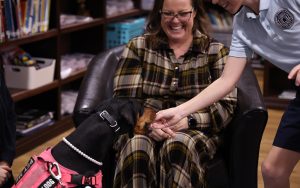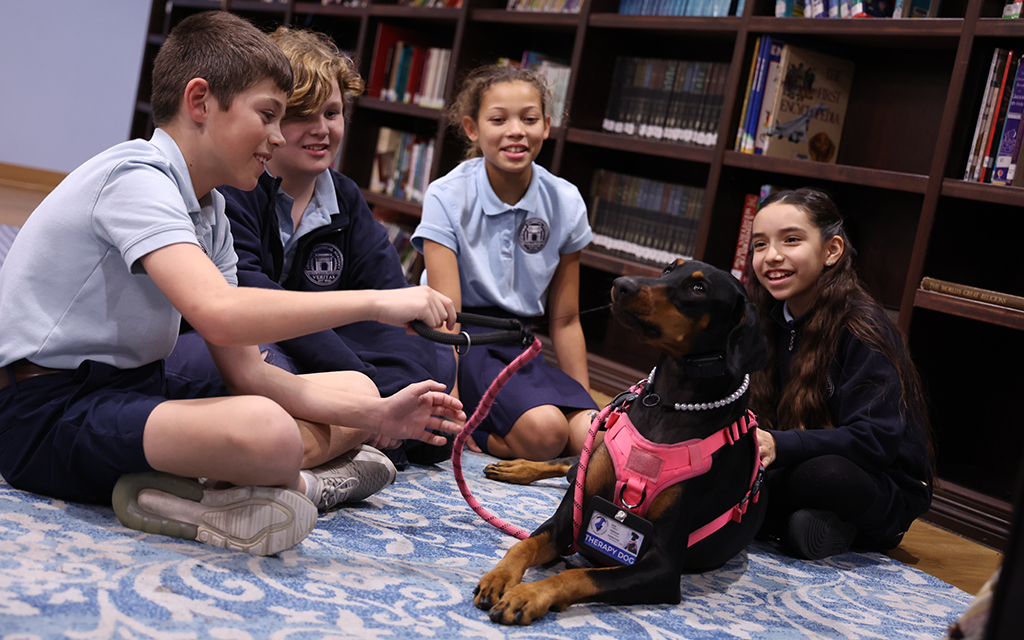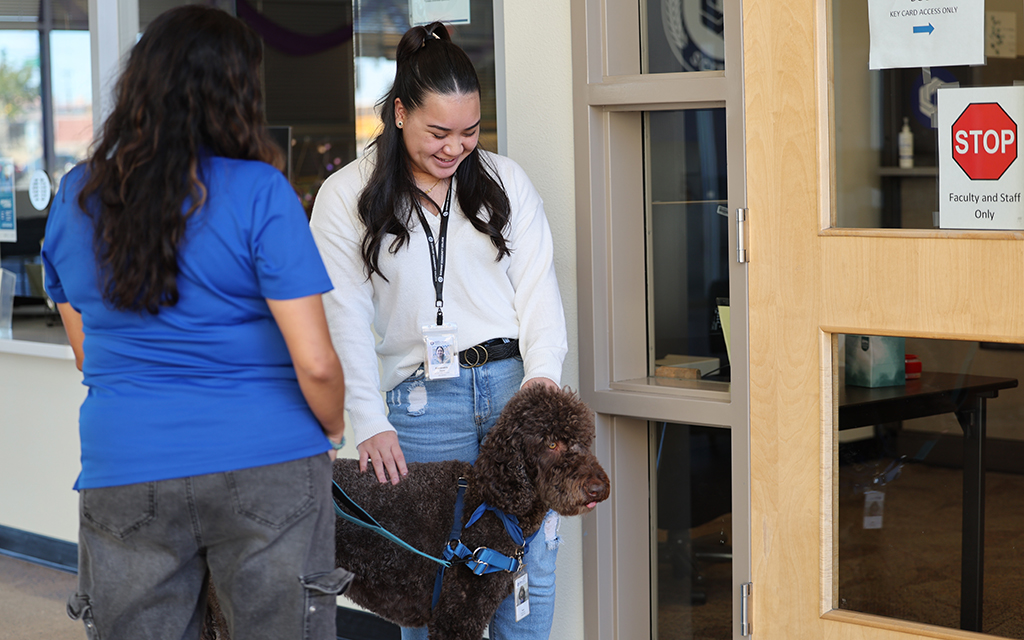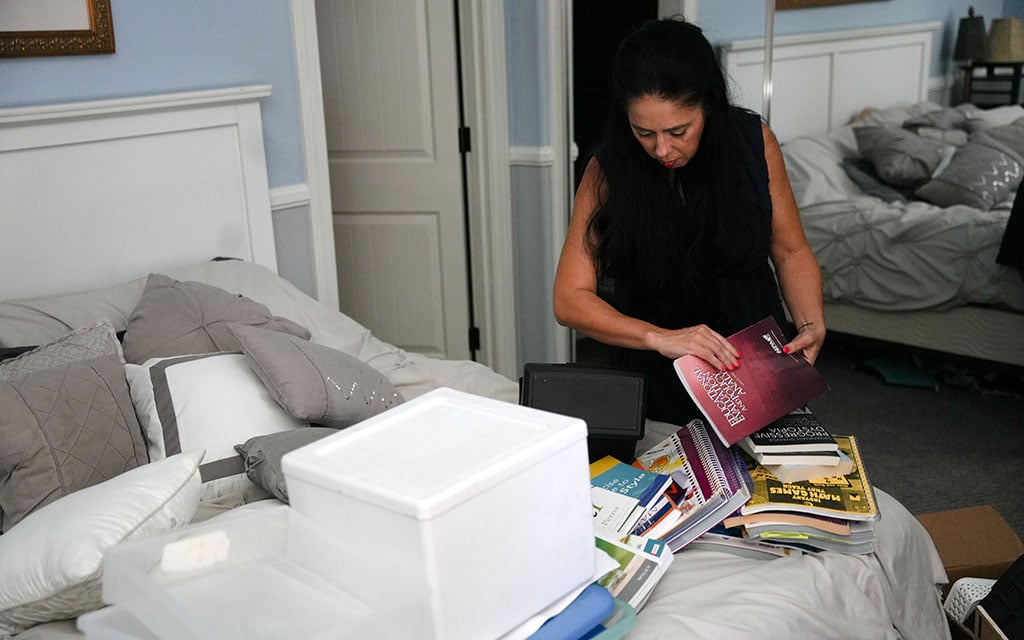
Alan Amaro pets therapy dog Dash at GateWay Community College on Jan. 30, 2024. Dash is handled by owner Monica Buensuceso. (Photo by Marnie Jordan/Cronkite News)
PHOENIX – If you’re a student at GateWay Community College you may see Dash visiting you in class, at school events and in the library and learning center. He’s also available to accompany students looking for counseling services.
Dash is a 65-pound labradoodle therapy dog owned by GateWay counseling faculty member Monica Buensuceso.
“People will say hi to him and not me, and it doesn’t hurt my feelings at all but it just shows that people like to see him and want to see him,” Buensuceso said. “They’ll pet him and I hear all the time people say, ‘Oh you made me feel better, oh thank you for the kisses,’ or just a smile … so you can just tell the animal just brings this happiness overall on campus and people just seem to want more.”
According to the American Animal Hospital Association, a therapy dog is a dog that “promotes improvement in human physical, social, emotional, or cognitive function, and functions in either group or individual settings.”

Great Hearts Archway Veritas Academy Director of Operations Ami Hosack, left, lets Jack Cooling, an 11-year-old fifth grader, feed therapy dog Karma at the school on Jan. 25, 2024. (Photo by Marnie Jordan/Cronkite News)
The Alliance of Therapy Dogs distinguishes therapy dogs from service dogs, whose duties focus solely on the needs of their handler. Therapy dogs, by contrast, are trained to “provide psychological or physiological therapy to individuals other than their handlers.”
A therapy dog can commonly be found visiting schools, hospitals, nursing homes and more.
Great Hearts Archway Veritas Academy has been utilizing a therapy dog since November 2023 – after the headmaster saw the success of Mabel, a bernedoodle at Great Hearts Glendale.
Ami Hosack, director of operations at Great Hearts Archway Veritas, volunteered her doberman pinscher Karma, one of Hosack’s four dogs whose personality and build made her a good candidate for therapy dog training.
“She just will accept everybody and anybody,” Hosack said.
It took just 10 Dog Training Elite sessions, once a week for 10 weeks, to prepare Karma for providing support to students at the school.
Karma had already been trained in the basics, such as “sit” and “down,” allowing her to advance quickly through the program.
A school day for Karma starts bright and early at Sunrise Club, where students whose parents need to drop them off before school starts line up to pet her. Hosack’s biggest priority is making sure Karma is available for students who need her.
“She ends up usually walking a lot of kindergartners to class in the morning because they have a harder time getting into class. But then they will usually hold onto her harness and walk with her and then they’re fine,” Hosack said.
Karma is also involved in reading intervention, providing “a sense of calm because she’s a nonjudgmental listener.”
She’s often simply there to provide love and comfort to students and faculty in need.

From left, fifth grader Jack Cooling, 11, fourth grader Henry Sprague, 10, and fifth graders Grace Gandy and Carly Bautista, both 10, spend time with therapy dog Karma at Great Hearts Archway Veritas Academy on Jan. 25, 2024. (Photo by Marnie Jordan/Cronkite News)
Therapy dogs take over Mesa Public Schools
Ella Wallace, director of community education and outreach for Mesa Public Schools, answered the call for support from students with her creation of the Paws & Peers program.
She said it started after a Mesa school board meeting in 2019 where students who were a part of the March For Our Lives movement spoke up for additional mental health support. Wallace said students shared stories of experiencing “despondency and anxiety and (being) overwhelmed with the pressures of being in high school.”
“They felt like they were just not capable.”
This prompted Wallace’s request to the superintendent for therapy dogs in Mesa schools and a thumbs-up to move forward.
“It was very important to me also that we incorporate rescues because of their story of the despondency and yet they’re resilient and they’re so loyal and they’re so appreciative,” she said of rescue dogs. “You can tell with a rescue oftentimes is just the love and gratefulness that they have for having a second chance.”
Wallace researched other schools that had utilized therapy dogs and found one in New York public schools that partnered with the North Shore Animal League America.
She, the superintendent, the school board president and five principals from Mesa public schools took a trip out to New York to meet with organizations and schools involved.
Mesa then began its pilot program, enlisting Angel Dogs, a local dog training program through East Valley K9 Services, to be their trainers. Wallace also established partnerships with North Shore Animal League and Yale University, which provided her with support through the necessary paperwork; Maricopa County Animal Care & Control; the Arizona Humane Society; and the Arizona Animal Welfare League.
“I had meetings with them to make sure that if our staff come to them with a rescue that they would identify in advance dogs who had demonstrated to have the temperament to become or be trained as a therapy dog,” Wallace said.
Potential therapy dogs for Paws & Peers must go through six weeks of obedience training and eight weeks of therapy dog training. They are trained specifically for therapy work by Angel Dogs, which customizes the training specifically for school districts, such as how to maintain a mild temperament during fire drills, buzzers at football games or loudspeaker announcements.
Staff members pay for their dog’s obedience training at a discounted rate and Mesa Public Schools covers half of the cost of therapy training.
Paws & Peers started with a dozen therapy dogs in just five schools in 2019. Today the program manages 91 therapy dogs in 45 schools in district locations from elementary to high school.
“We’re the largest-known therapy-dog program in the country,” Wallace said.
Staff with therapy dogs in the program are monitored through a formal observation each year to make sure they’re continuing with high-quality instruction to students.
“I go in and see how the dog is doing, how the handler’s working with their students, but also using the dog in their lesson, formally check in with them and provide feedback and give them ideas on how to best incorporate the dog and make sure they’re following guidelines and expectations of the program,” said Paige Kistner, Paws & Peers support specialist for Mesa Public Schools.
Since the program’s inception, Wallace said faculty have noticed significant improvements in students from increased attendance rates to better socialization in previously shy students, to an overall better attitude and respect for one another on school grounds.
So, why aren’t more school districts using therapy dogs as a form of support for students and faculty?
Wallace explained the process not only involves a significant amount of paperwork, but support from administrators.
“First thing I’ll tell them is you’ve got to get the approval of your superintendent, your school board and your legal counsel,” she said.

GateWay counseling faculty member Monica Buensuceso, left, lets office assistant Alexandria Chaco pet therapy dog Dash at GateWay Community College on Jan. 30, 2024. Buensuceso says people want to see more of Dash. “They’ll say hi to him and not me,” she says. (Photo by Marnie Jordan/Cronkite News)
Labradoodle Dash comforts college students
Therapy dogs are not just helpful for K-12 students, but for those pursuing higher education as well. For GateWay Community College students, Dash offers them a lot of support.
Prior to Dash’s arrival on campus, Buensuceso enrolled him in basic dog training, followed by therapy dog training at her local Petsmart to receive certification from the Alliance of Therapy Dogs.
The alliance performs tests to ensure the dog is nonreactive in various settings and has the temperament to be around humans and possibly other animals all the time.
Once the dog passes all the tests, the handler must ensure they are maintaining a certain number of volunteer hours to keep the certification active.
Buensuceso volunteered with Dash at a high school she previously worked at, and with The Opportunity Tree, a nonprofit organization for adults and youth with intellectual and developmental disabilities.
“I’ve been invited to class where they’ll be like, ‘We’re having a test, can Dash just come by and do a quick little everybody pet him and feel good and then leave?’” Buensuceso said.
Dash’s success on campus became truly recognizable when Buensuceso was approached by the school’s president after students repeatedly voiced requests for more of Dash on campus.
“That was when I think the president realized, ‘Wow this dog is making a difference,’ because that’s when she came to us. It was like, ‘This is big; we need to really go with that,’” Buensuceso said.


